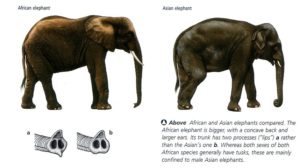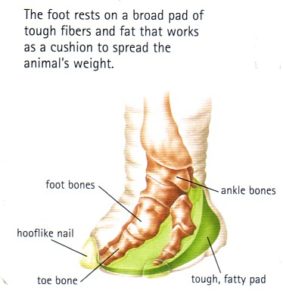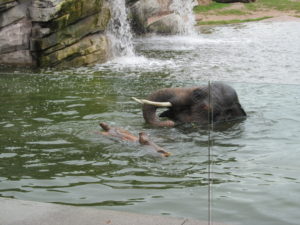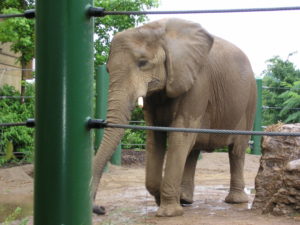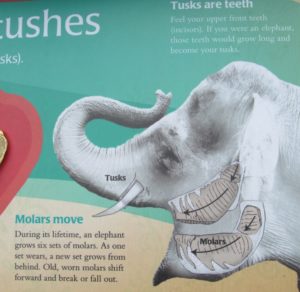The elephant is another animal that exhibits numerous characteristics that required marvelous engineered solutions. Most people would agree that the elephant is a unique animal with a very distinct look. As an engineer I have been trained to recognize design. And, in every design there is always at least one designer. Evolutionists would like us all to believe that in the case of living things, design is the result of deep time, natural selection, and mutations. They would like us to believe that brainless nature is a designer with the fantastic ability to give us the great variety we see all around us. In their minds living things only exhibit the “appearance of design.” This is an absurdity that results when men attempt to reject the Creator God!
Today, there are two basic types of elephants, the African and the Asian. In the image below can be seen the differences in these two variations of the elephant kind.
In this article we will look at a few of the most outstanding engineered characteristics of the elephant, namely the feet, the trunk, the ears, and the teeth.
Elephant Feet: Elephants can weigh over six tons! All of that weight must be transmitted to the ground through their feet. As can be seen in the image below, an elephant’s foot structure is such that it is standing on its tiptoes. The foot bones are surrounded by fat and there is a pad of tough fibers and fat that cushions the load to the ground by the foot.
If elephants had evolved from other land animals they would have gone extinct long ago. This is because the elephant’s foot is different from other animals. The elephant foot and lower leg has a unique design that is made so as to prevent the animal from getting stuck in mud. When the elephant lifts a leg in the mud, the diameter of the leg becomes smaller which makes it easier for the animal to lift its leg out of the mud. This engineered design was needed from the beginning and was foreseen as necessary by the greatest Engineer of all. He knew if elephants could not extricate themselves from mud, they would soon become extinct.
Elephant’s Trunk: An elephant’s trunk is an amazing thing, probably impossible to ever completely duplicate through the efforts of man. The elephant uses its trunk to breathe, scratch, greet and hug a friend, handle tiny or large loads, locate and grab food, tear up food, and place food in its mouth. In addition, the elephant can use its trunk to suck up water, take a shower, sense enemies, sprinkle itself with dust and mud to protect from the hot sun or biting insects, dig for water, and make a variety of sounds. A human workman would need a large tool truck filled with a variety of large and small tools to accomplish what the elephant can do with its trunk alone! It requires a fantastic imagination to conjure up an explanation for how this complicated tool could ever have come about by evolutionary random-chance accidents.
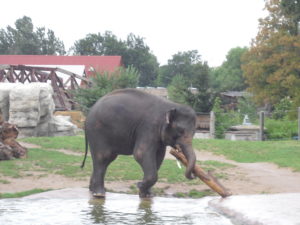
Elephant Ears: Warm-blooded animals generate heat when they digest their food. Generally, the larger the animal the more heat that is generated. The elephant is a very large animal that normally lives in warmer climates. How does the elephant cool down so it won’t overheat?
It does so by taking advantage of its large ears, engineered with many large blood vessels which carry blood through the thin ear membrane. When the elephant moves its ears close to or away from its body, it can control the rejection of heat from its body by convection and radiation. The maximum effect takes place when the ears are extended out from the body and flapped. What we see here is another engineering problem solved in the beginning of creation by the Master Engineer.
Elephant Teeth: The tusks of the elephant are actually considered to be large incisor teeth. Tusks can grow to be over ten feet long, starting to grow at about two years of age. Both males and females have tusks. Tusks are made of a hard white material called ivory. Ivory has been used for thousands of years for decorative ornaments, tools, and weapons. Today, in spite of laws and roving game wardens, many elephants are killed by poachers for their ivory. There are thought to be fewer than 50,000 elephants left in the world today.
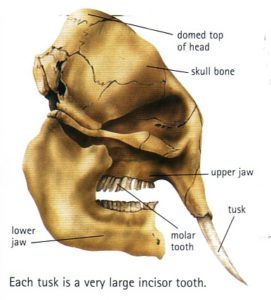 If not killed by humans or large predators, elephants can live to be more than sixty years of age. Throughout their long lives elephants grow six sets of molar teeth to grind their food. As old teeth wear out new sets of molars drop in behind and the old sets break into pieces or fall out.
If not killed by humans or large predators, elephants can live to be more than sixty years of age. Throughout their long lives elephants grow six sets of molar teeth to grind their food. As old teeth wear out new sets of molars drop in behind and the old sets break into pieces or fall out.
The teeth, feet, trunk, and ears of elephants all exhibit many elements of design, not the evidence of slow evolution. Glory be to God the Great Engineer!
J.D. Mitchell
